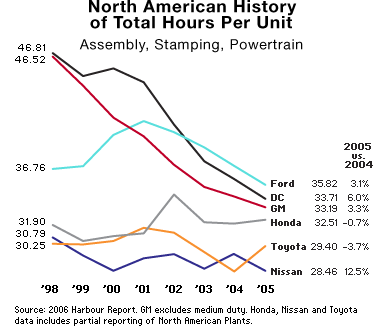
In what has become a true horse-race among North American auto makers, Nissan Motor Co. Ltd. won by a nose to become the No.1 ranked producer in the annual Harbour Report on automotive productivity.
Nissan edged out last year’s winner, Toyota Motor Corp., by a small margin, followed in close succession by Honda Motor Co. Ltd., General Motors Corp., Chrysler Group and Ford Motor Co. The 2006 study measured performance in the 2005 calendar year.
The 2006 report also includes four assembly plants previously not in the study: Honda’s Alliston, Ont., Canada, No.1 and Lincoln, AL, No.1 assembly lines; Nissan’s Canton, MS, plant; and Toyota’s two assembly lines in Princeton, IN.
While the top three producers all are Japanese, the report is not the indictment of Detroit’s efficiency it once was, says Ron Harbour, president of Harbour Consulting Inc., the company that compiles the report.
Even so, he points out that Toyota, Nissan, Honda, DaimlerChrysler and Hyundai increased their share in a North American market that has not grown, adding Toyota is gaining the equivalent of one assembly plant per year in new market share in North America.
Published since 1989, the benchmarking study used to reveal huge differences between Detroit-based and Japanese producers in the number of man hours per vehicle needed to build cars and trucks. It provided clear-cut evidence why GM, Ford and Chrysler were struggling to compete with their Asian rivals.

As recently as 1998, there were as many as 17 hours per vehicle separating the best and worst performers in the study, Harbour says. That gap has narrowed markedly in recent years. It is only about 7 hours per vehicle in the 2006 study.
“Everybody continues to improve. When you look at the discreet productivity numbers, there is a lot more parity than ever before. The differences from top to bottom are becoming less and less,” Harbour says.
Harbour points out that GM and Ford logged productivity gains of about 3% during 2005, impressive and difficult feats because both were scaling back production at the time.
The fact that GM and Ford continued to bolster factory efficiency independent of production fluctuations is significant, he says.
“But to say they’re all the same now would ignore some glaring differences that still exist,” Harbour adds. Detroit auto makers still lag Toyota, Honda and Nissan in several critical areas: the time it takes to launch new vehicles and plant flexibility.
“Toyota launched the Camry in 16 days. Honda has had similar numbers with the Civic. Nissan has had similar numbers with some of its vehicles.” Detroit auto makers can’t come close to matching that, Harbour says.
Plant flexibility also is key, and it shows up in capacity utilization, a key factor in auto maker profitability. GM’s plant capacity utilization ranges from 143% to 23%. In other words, it has some plants running on massive overtime schedules while others are running at less than a quarter of their rated straight-time capacity.
Ideally, an auto maker should be able to shift production from overtaxed plants to those with extra room available on their assembly lines. That’s what Toyota is able to do. Its capacity utilization ranges from a high of 109% to a low of 97%, according to the study.
None of Detroit’s Big Three are that flexible. While GM, Ford and Chrysler are making progress in the area of flexibility, Harbour says they still have a long way to go.
The most controversial aspect of the 2006 report is that four of the most efficient auto plants in North America – including the top two – are scheduled to be shut down or already closed.
Ford’s Atlanta assembly plant, which builds the Taurus sedan for rental fleets and has been one of the top performers in the study for years, is ranked No.1. It is scheduled to be closed later this year. GM’s Oshawa No.2 plant, another perennial standout that builds the Pontiac Grand Prix and Buick LaCrosse, is slated for closure in 2008.
GM’s Lansing M plant, which built the Pontiac Grand Am and Malibu Classic, already has been closed. Saturn’s Ion production line in Spring Hill, TN, ranked No.10 on the list, also will be idled.
Harbour says it is unfortunate so many highly productive plants find themselves slated to be shuttered, but he points out that many issues beyond productivity are factored into the decision to close a plant.
“They’re really a victim of circumstances, it’s not the people,” he says Other highlights:
• Chrysler logged an impressive 6% gain overall, allowing it to pass Ford in assembly plant productivity for the first time.
• After suffering some notorious launch and quality problems, Nissan’s plant in Canton, which builds the Armada and Infiniti QX56 fullsize SUVs, the Titan fullsize pickup; Nissan Quest minivan; and Altima sedan, actually led the fullsize SUV segment in productivity, beating out seven competitors, including GM’s plant in Arlington, TX, and Toyota’s factory in Princeton.
• Toyota and Honda lost ground in 2005, dropping 3.7% and 0.7%, respectively, as their volumes grew.
• Nissan enjoyed a whopping 12.5% increase compared with year-ago. However, the results are skewed somewhat as they do not include Nissan’s two Mexican operations. Because labor costs are much lower in Mexico, most plants there tend to be far more labor intensive than in the rest of North America.




